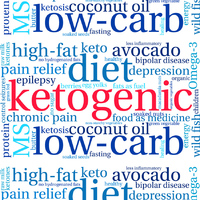Epilepsy is a serious brain disorder, affecting 65 million people worldwide. The condition is caused by excessive and abnormal brain cell activity and is diagnosed when two or more unprovoked seizures occur.
Epilepsy occurs most often in young children and in the elderly. The ketogenic diet is a treatment strategy usually recommended for children who are not responding to various seizure medication regimens after several trials.
What is the ketogenic diet?
The ketogenic diet is a treatment used to treat pediatric epilepsy. It has been used as an effective method of treatment for epilepsy for many years. It was developed at the Mayo Clinic in the 1920’s.
The diet requires medical supervision, as well as close surveillance by a dietitian. The patient is required to start the treatment with a four-day hospital stay. The purpose of the hospital stay is so that the patient can be monitored for side effects as they progress towards a state of ketosis. The hospital stay usually starts with a fasting period that helps achieve the state of ketosis more quickly.
What is ketosis?
Ketosis occurs when the body uses fat as a primary source of fuel. Normally, carbohydrates such as bread, rice, and pasta are a main source of fuel for the body. This makes sense because the brain primarily uses glucose (carbohydrates are converted to glucose in the body) for energy.
When the intake of carbohydrates is very low, the body thinks that it is in a fasting/starvation state. It then switches from carbohydrates to fats as the main source of energy. Fat stored in adipose tissues is released into the blood as free fatty acids. However, the free fatty acids cannot cross the blood-brain barrier to provide fuel to brain cells. To compensate for this, the fatty acids are converted to ketones by the liver and then are able to provide energy to the brain when glucose is limited.
It is not yet known how ketosis controls seizures, but the beneficial effect of the ketogenic diet is well demonstrated. Some think the ketones have an anticonvulsant effect as they cross the blood-brain barrier.
Composition of the Ketogenic Diet
The ketogenic diet is high fat, low-carbohydrate, and provides adequate protein. After the medical team for the pediatric epileptic patient decides that the ketogenic diet is the best strategy for controlling seizures, a dietitian calculates a personalized plan. The plan has a specific ratio of fats, which produce ketones, to carbohydrates and proteins, which reduce ketone production. The typical ketogenic ratio for treating pediatric epilepsy is 4:1 to maintain an optimal state of ketosis and provide seizure control, with 90% of energy/calories being provided by fat and 10% from carbohydrates and protein. It is important to note that the ratio can vary by individual. A 3:1 ratio is recommended for infants, children, and adolescents who require more protein and/or carbohydrate for some other reason.
What foods can be eaten on the ketogenic diet?
An example of a food that meets the 4:1 ratio all by itself is the avocado. However, most foods do not naturally meet the ratio, so it is necessary to combine the appropriate foods together to create the right ratio. Foods must be weighed on a gram scale to ensure that the ratio is correct.
The following foods can be used to create a ketogenic meal:
|
Protein |
Carbohydrate |
Cream |
Fat |
|
Eggs |
Lettuce |
Cream |
Butter |
|
Bacon |
Tomato |
Whipped cream |
Coconut oil |
|
Sausage |
Squash |
Ice cream |
Margarine |
|
Chicken |
Broccoli |
Cocoa |
Mayo |
|
Pork |
Carrots |
Sherbert |
Oils |
|
Beef |
Green beans |
Popsicle |
|
|
Fish |
Applesauce |
|
|
|
Cheese |
Strawberries |
|
|
|
Hot Dogs |
Peach |
|
|
Zupec-Kania, B. The Ketogenic Diet Journey.
The Charlie Foundation and Nutricia North America, 2007.
Here’s a sample 1400-calorie menu plan from Boston Children’s Hospital using the 4:1 ratio:
Breakfast
Scrambled eggs made with the following ingredients:
- Heavy cream: 38 g (2.7 tbsp)
- Eggs: 50 g (1 large egg)
- Butter: 27 g (1.9 tbsp)
- Strawberries: 12 g (1 medium)
Lunch
Quesadilla with creamy avocado dip made with the following ingredients:
- Heavy cream: 20 g (1.4 tbsp)
- Mayonnaise: 11 g (2.3 tsp)
- Olive oil: 5 g (1 tsp)
- Avocado: 23 g (one-sixth of an avocado)
- Butter: 10 g (0.7 tbsp)
- Egg whites: 30 g (white from 1 large egg)
- Almond flour: 5 g (2 tsp)
- Grated cheddar cheese: 12 g (0.4 oz)
Dinner
Chicken salad served on an iceberg lettuce leaf made with:
- Heavy cream: 41 g (2.9 tbsp)
- Cooked chicken breast: 20 g (0.7 oz)
- Mayonnaise: 31 g (2.2 tbsp)
- Cucumbers and tomatoes: 34 g (1.2 oz)
Snack
- Macadamia nuts: 26 g (0.9 oz)
- Orange: 15 g (one-tenth of an orange)
Increasing Variety
The ketogenic diet can be challenging because of its need for strict compliance and precise food measurements. Charlie’s Foundation has a robust recipe section filled with creative recipes using key ingredients from the ketogenic diet:
- Blueberry Chia Jam (features chia seeds, which are low in carbohydrate and function as a thickener)
- Coconut Mayonnaise (features coconut oil and extra virgin olive oil)
- Spreadable Peanut Butter (features coconut oil and liquid stevia)
- Basil Pesto (features unsalted macadamia nuts and olive oil)
- Flax Hemp Crackers (features flaxseed and hemp seed, which have almost zero carbohydrates and provide the crunch of crackers)
- Coconut Milk and Chia Seed Pudding (features coconut milk and chia seeds)
Other Considerations
There are a few other things to consider when following the ketogenic diet:
- Medications must be checked for carbohydrates and sugar because they will also be factored into the ratio calculated by the dietitian.
- Because of the restricted nature of the diet, the dietitian or physician will recommend supplements such as multivitamins, calcium, and vitamin D to make sure that the child receives all the necessary nutrients.
- Children on the ketogenic diet may experience side effects such as hyperlipidemia (elevated blood lipid levels), metabolic acidosis, kidney stones, and constipation. In this case the ketogenic diet may be stopped, or the dietitian may lower the ratio.
- The child will usually need to test ketones every day at home using a simple urine strip test.
- The ketogenic should be tried for at least three months. Some children improve in a few weeks, while others take a bit more time. The good news is that the diet does not have to be implemented forever. Doctors usually recommend that the ketogenic be practiced for 2 years.
The ketogenic diet has been shown to be an effective treatment for pediatric epilepsy. Several studies have shown that the protocol reduces or prevents seizures in children who have not had success with medications. More than half the children who use the ketogenic diet experience at least a 50% reduction in seizures, while 10-15% become seizure-free.
To learn more, please talk with your physician and check out the following resources:
- Charlie’s Foundation website
- Matthew’s Friends Website
- www.ketocook.com
- www.luriechildrens.org (search epilepsy or ketogenic diets)
...and remember, qualified nutritionists at Healthy Being are available to offer further general advice to help guide you in selecting the right products. So please, feel free to contact us at anytime!
 Aminta Bullard is a Master's-trained Registered Dietitian and a regular contributor to HB Insights. She specialises in health and nutrition communications, as well as nutrition education.
Aminta Bullard is a Master's-trained Registered Dietitian and a regular contributor to HB Insights. She specialises in health and nutrition communications, as well as nutrition education.


 Certified Organic
Certified Organic Vegan Friendly
Vegan Friendly  Vegetarian
Vegetarian Organic Ingredients
Organic Ingredients Dairy Free
Dairy Free Gluten Free
Gluten Free Keto Friendly
Keto Friendly





























